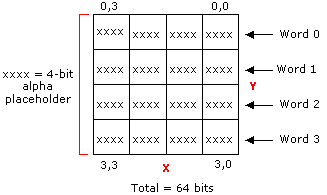Textures with alpha channels
There are two ways to encode texture maps that exhibit more complex transparency. In each case, a block that describes the transparency precedes the 64-bit block already described. The transparency is either represented as a 4x4 bitmap with 4 bits per pixel (explicit encoding), or with fewer bits and linear interpolation that is analogous to what is used for color encoding.
The transparency block and the color block are arranged as shown in the following table.
| Word address | 64-bit block |
|---|---|
| 3:0 | Transparency block |
| 7:4 | Previously described 64-bit block |
Explicit texture encoding
For explicit texture encoding (BC2 format), the alpha components of the texels that describe transparency are encoded in a 4x4 bitmap with 4 bits per texel. These four bits can be achieved through a variety of means such as dithering or by using the four most significant bits of the alpha data. However they are produced, they are used just as they are, without any form of interpolation.
The following diagram shows a 64-bit transparency block.

Note The compression method of Direct3D uses the four most significant bits.
The following tables illustrate how the alpha information is laid out in memory, for each 16-bit word.
Layout for word 0:
| Bits | Alpha |
|---|---|
| 3:0 (LSB*) | [0][0] |
| 7:4 | [0][1] |
| 11:8 | [0][2] |
| 15:12 (MSB*) | [0][3] |
*least-significant bit, most significant bit (MSB)
Layout for word 1:
| Bits | Alpha |
|---|---|
| 3:0 (LSB) | [1][0] |
| 7:4 | [1][1] |
| 11:8 | [1][2] |
| 15:12 (MSB) | [1][3] |
Layout for word 2:
| Bits | Alpha |
|---|---|
| 3:0 (LSB) | [2][0] |
| 7:4 | [2][1] |
| 11:8 | [2][2] |
| 15:12 (MSB) | [2][3] |
Layout for word 3:
| Bits | Alpha |
|---|---|
| 3:0 (LSB) | [3][0] |
| 7:4 | [3][1] |
| 11:8 | [3][2] |
| 15:12 (MSB) | [3][3] |
The color compare used in BC1 to determine if the texel is transparent is not used in this format. It is assumed that without the color compare the color data is always treated as if in 4-color mode.
Three-bit linear alpha interpolation
The encoding of transparency for the BC3 format is based on a concept similar to the linear encoding used for color. Two 8-bit alpha values and a 4x4 bitmap with three bits per pixel are stored in the first eight bytes of the block. The representative alpha values are used to interpolate intermediate alpha values. Additional information is available in the way the two alpha values are stored. If alpha_0 is greater than alpha_1, then six intermediate alpha values are created by the interpolation. Otherwise, four intermediate alpha values are interpolated between the specified alpha extremes. The two additional implicit alpha values are 0 (fully transparent) and 255 (fully opaque).
The following code example illustrates this algorithm.
// 8-alpha or 6-alpha block?
if (alpha_0 > alpha_1) {
// 8-alpha block: derive the other six alphas.
// Bit code 000 = alpha_0, 001 = alpha_1, others are interpolated.
alpha_2 = (6 * alpha_0 + 1 * alpha_1 + 3) / 7; // bit code 010
alpha_3 = (5 * alpha_0 + 2 * alpha_1 + 3) / 7; // bit code 011
alpha_4 = (4 * alpha_0 + 3 * alpha_1 + 3) / 7; // bit code 100
alpha_5 = (3 * alpha_0 + 4 * alpha_1 + 3) / 7; // bit code 101
alpha_6 = (2 * alpha_0 + 5 * alpha_1 + 3) / 7; // bit code 110
alpha_7 = (1 * alpha_0 + 6 * alpha_1 + 3) / 7; // bit code 111
}
else {
// 6-alpha block.
// Bit code 000 = alpha_0, 001 = alpha_1, others are interpolated.
alpha_2 = (4 * alpha_0 + 1 * alpha_1 + 2) / 5; // Bit code 010
alpha_3 = (3 * alpha_0 + 2 * alpha_1 + 2) / 5; // Bit code 011
alpha_4 = (2 * alpha_0 + 3 * alpha_1 + 2) / 5; // Bit code 100
alpha_5 = (1 * alpha_0 + 4 * alpha_1 + 2) / 5; // Bit code 101
alpha_6 = 0; // Bit code 110
alpha_7 = 255; // Bit code 111
}
The memory layout of the alpha block is as follows:
| Byte | Alpha |
|---|---|
| 0 | Alpha_0 |
| 1 | Alpha_1 |
| 2 | [0][2] (2 MSBs), [0][1], [0][0] |
| 3 | [1][1] (1 MSB), [1][0], [0][3], [0][2] (1 LSB) |
| 4 | [1][3], [1][2], [1][1] (2 LSBs) |
| 5 | [2][2] (2 MSBs), [2][1], [2][0] |
| 6 | [3][1] (1 MSB), [3][0], [2][3], [2][2] (1 LSB) |
| 7 | [3][3], [3][2], [3][1] (2 LSBs) |
The color compare used in BC1 to determine if the texel is transparent is not used with these formats. It is assumed that without the color compare the color data is always treated as if in 4-color mode.
Related topics
Feedback
Coming soon: Throughout 2024 we will be phasing out GitHub Issues as the feedback mechanism for content and replacing it with a new feedback system. For more information see: https://aka.ms/ContentUserFeedback.
Submit and view feedback for